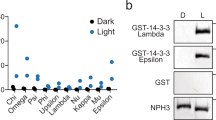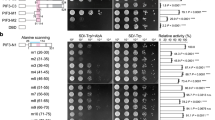Abstract
Because plants are sessile, they have developed intricate strategies to adapt to changing environmental variables, including light. Their growth and development, from germination to flowering, is critically influenced by light, particularly at red (660 nm) and far-red (730 nm) wavelengths1,2. Higher plants perceive red and far-red light by means of specific light sensors called phytochromes(A–E)3. However, very little is known about how light signals are transduced to elicit responses in plants. Here we report that nucleoside diphosphate kinase 2 (NDPK2) is an upstream component in the phytochrome signalling pathway in the plant Arabidopsis thaliana. In animal and human cells, NDPK acts as a tumour suppressor4. We show that recombinant NDPK2 in Arabidopsis preferentially binds to the red-light-activated form of phytochrome in vitro and that this interaction increases the activity of recombinant NDPK2. Furthermore, a mutant lacking NDPK2 showed a partial defect in responses to both red and far-red light, including cotyledon opening and greening. These results indicate that NDPK2 is a positive signalling component of the phytochrome-mediated light-signal-transduction pathway in Arabidopsis.
This is a preview of subscription content, access via your institution
Access options
Subscribe to this journal
Receive 51 print issues and online access
$199.00 per year
only $3.90 per issue
Buy this article
- Purchase on Springer Link
- Instant access to full article PDF
Prices may be subject to local taxes which are calculated during checkout





Similar content being viewed by others
References
von Arnim,A. & Deng, X.-W. Light control of seedling development. Annu. Rev. Plant Physiol. Plant Mol. Biol. 47, 215–243 (1996).
Fankhauser,C. & Chory,J. Light control of plant development. Annu. Rev. Cell Dev. Biol. 13, 203–229 (1997).
Bowler,C., Neuhaus,G., Yamagata,H. & Chua,N. H. Cyclic GMP and calcium mediate phytochrome phototransduction. Cell 77, 73–81 (1994); erratum, ibid 79, 743 (1994).
de la Rosa,A., Williams,R. L. & Steeg,P. S. Nm23/nucleotide diphosphate kinase: toward a structural and biochemical understanding of its biological functions. Bioessays 17, 53–62 (1995).
Elich,T. D. & Chory,J. Photochrome: if it looks and smells like a histidine kinase, is it a histidine kinase? Cell 91, 713–716 (1997).
Yeh,K. C., Wu,S. H., Murphy,J. T. & Lagarias,J. C. A cyanobacterial phytochrome two-component light sensory system. Science 277, 1505–1508 (1997).
Kwok,S. F., Piekos,B., Misera,S. & Deng,X. W. A complement of ten essential and pleiotropic arabidopsis COP/DET/FUS genes is necessary for repression of photomorphogenesis in darkness. Plant Physiol. 110, 731–742 (1996).
Whitelam,G. C. et al. Phytochrome A null mutants of Arabidopsis display a wild-type phenotype in white light. Plant Cell 5, 757–768 (1993).
Ahmad,M. & Cashmore,A. R. The pef mutants of Arabidopsis thaliana define lesions early in the phytochrome signaling pathway. Plant J. 10, 1103–1110 (1996).
Barnes,S. A., Quaggio,R. B., Whitelam,G. C. & Chua,N. H. fhy1 defines a branch point in phytochrome a signal transduction pathways for gene expression. Plant J. 10, 1155–1161 (1996).
Wagner,D., Hoecker,U. & Quail,P. H. RED1 is necessary for phytochrome B-mediated red light-specific signal transduction in Arabidopsis. Plant Cell 9, 731–743 (1997).
Hoecker,U., Xu,Y. & Quail,P. H. SPA1: a new genetic locus involved in phytochrome A-specific signal transduction. Plant Cell 10, 19–33 (1998).
Soh,M. S., Hong,S. H., Hanzawa,H., Furuya,M. & Nam,H. G. Genetic identification of FIN2, a far red light-specific signaling component of Arabidopsis thaliana. Plant J. 16, 411–419 (1998).
Ni,M., Tepperman,J. M. & Quail,P. H. PIF3, a phytochrome-interacting factor necessary for normal photoinduced signal transduction, is a novel basic helix-loop-helix protein. Cell 95, 657–667 (1998).
Fankhauser,C. et al. PKS1, a substrate phosphorylated by phytochrome that modulates light signaling in Arabidopsis. Science 284, 1539–1541 (1999).
Zimmermann,S. et al. UV responsive genes of Arabidopsis revealed by similarity to the Gcn4 mediated UV response in yeast. J. Biol. Chem. 274, 17017–17024 (1999).
Wagner,D., Fairchild,C. D., Kuhn,R. M. & Quail,P. H. Chromophore-bearing NH2-terminal domains of phytochromes A and B determine their photosensory specificity and differential light lability. Proc. Natl Acad. Sci. USA 93, 4011–4015 (1996).
Dearolf,C. R., Hersperger,E. & Shearn,A. Developmental consequence of awdb3, a cell autonomous lethal mutation of Drosophila induced by hybrid dysgenesis. Dev. Biol. 13, 203–229 (1988).
Biggs,J., Hersperger,E., Steeg,P. S., Liotta,L. A. & Shearn,A. A Drosophila gene that is homologous to a mammalian gene associated with tumor metastasis codes for a nucleoside diphosphate kinase. Cell 63, 933–940 (1990).
Engel,M. et al. A novel serine/threonine-specific protein phosphotransferase activity of Nm23/nucleotide-diphosphate kinase. Eur. J. Biochem. 234, 200–207 (1995).
Lu,Q., Park,H., Egger,L. A. & Inouye,M. Nucleoside-diphosphate kinase-mediated signal transduction via histidyl- aspartyl phosphorelay systems in Escherichia coli. J. Biol. Chem. 271, 32886–32893 (1996).
Wagner,P. D., Steeg,P. S. & Vu,N. D. Two-component kinase-like activity of nm23 correlates with its motility-suppressing activity. Proc. Natl Acad. Sci. USA 94, 9000–9005 (1997).
Bominaar,A. A., Molijn,A. C., Pestel,M., Veron,M. & Van Haastert,P. J. Activation of G-proteins by receptor-stimulated nucleoside diphosphate kinase in Dictyostelium. EMBO J. 12, 2275–2279 (1993).
Ogura,T., Tanaka,N., Yabe,N., Komatsu,S. & Hasunuma,K. Characterization of protein complexes containing nucleoside disphosphate kinase with characteristics of light signal transduction through phytochrome in etiolated pea seedlings. Photochem. Photobiol. 69, 397–403 (1999).
Lapko,V. N. & Song,P. S. A simple and improved method of isolation and purification for native oat phytochrome. Photochem. Photobiol. 62, 194–198 (1995).
Sommer,D. & Song,P. S. A plant nucleoside diphosphate kinase homologous to the human Nm23 gene product: purification and characterization. Biochim. Biophys. Acta 1222, 464–470 (1994).
Kosower,E. M. & Kosower,N. S. Bromobimane probes for thiols. Methods Enzymol. 251, 133–148 (1995).
Feldmann,K. A. T-DNA insertion mutagenesis in Arabidopsis-mutational spectrum. Plant J. 1, 71–82 (1991).
Acknowledgements
This work was supported by the Kumho Petrochemical Co., the Korea Science and Engineering Foundation, The Academic Research Fund of the Ministry of Education, Republic of Korea and USPHS-NIH. We thank the Arabidopsis Stock Centre for sending seeds.
Author information
Authors and Affiliations
Corresponding author
Rights and permissions
About this article
Cite this article
Choi, G., Yi, H., Lee, J. et al. Phytochrome signalling is mediated through nucleoside diphosphate kinase 2. Nature 401, 610–613 (1999). https://doi.org/10.1038/44176
Received:
Accepted:
Issue Date:
DOI: https://doi.org/10.1038/44176
This article is cited by
-
Growth, physiological and proteomic responses in field grown wheat varieties exposed to elevated CO2 under high ambient ozone
Physiology and Molecular Biology of Plants (2020)
-
Transcriptome profiling reveals cytokinin promoted callus regeneration in Brassica juncea
Plant Cell, Tissue and Organ Culture (PCTOC) (2020)
-
UVR8 interacts with WRKY36 to regulate HY5 transcription and hypocotyl elongation in Arabidopsis
Nature Plants (2018)
-
Comparative proteomic and physiological analyses reveal the role of zinc on Arthrospira platensis response to low-temperature stress
Journal of Applied Phycology (2018)
-
White stripe leaf 12 (WSL12), encoding a nucleoside diphosphate kinase 2 (OsNDPK2), regulates chloroplast development and abiotic stress response in rice (Oryza sativa L.)
Molecular Breeding (2016)
Comments
By submitting a comment you agree to abide by our Terms and Community Guidelines. If you find something abusive or that does not comply with our terms or guidelines please flag it as inappropriate.



